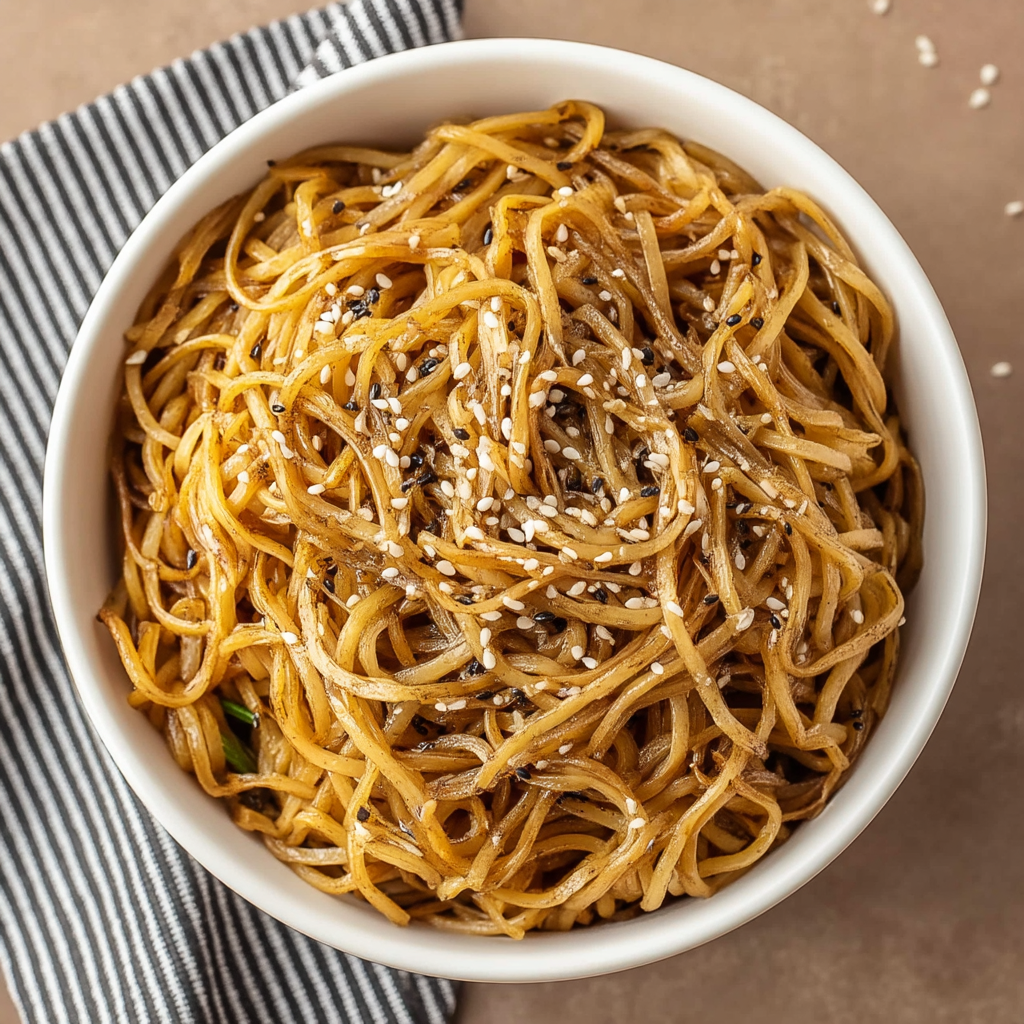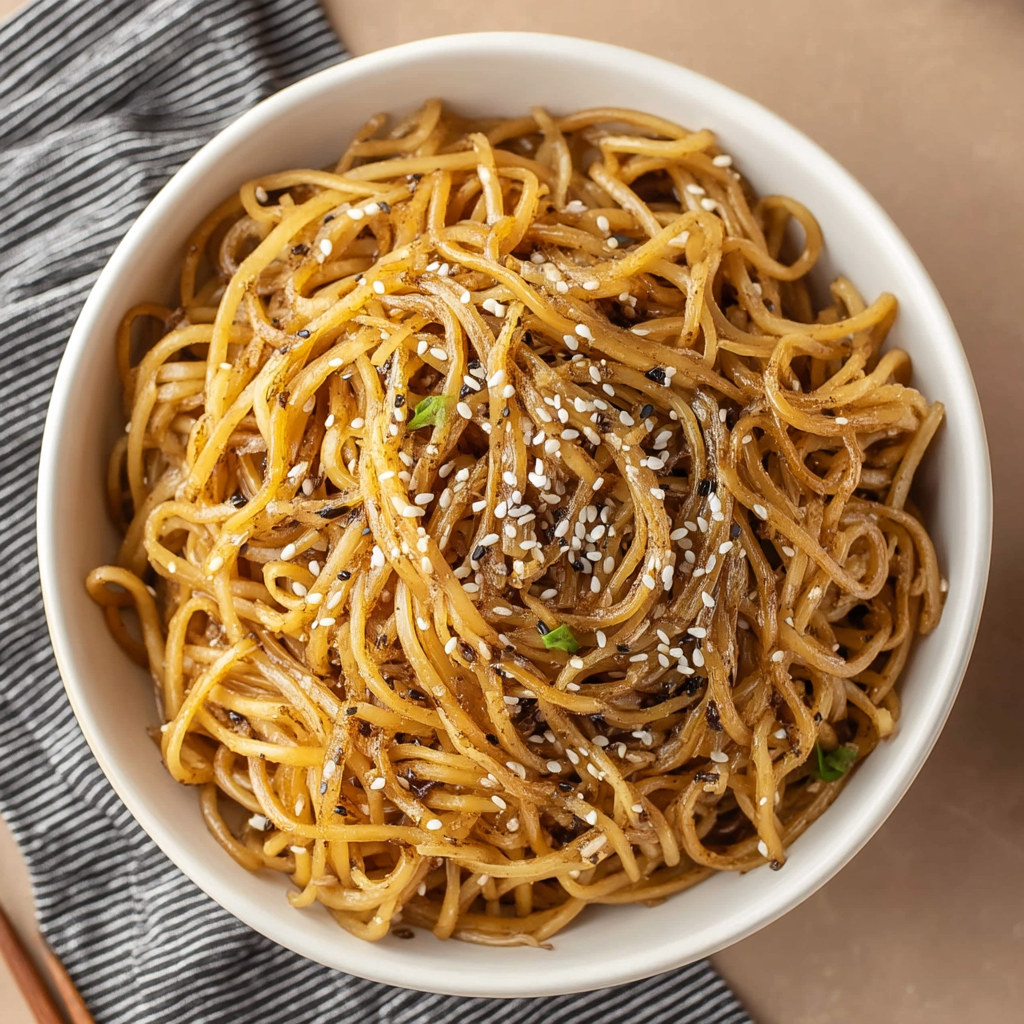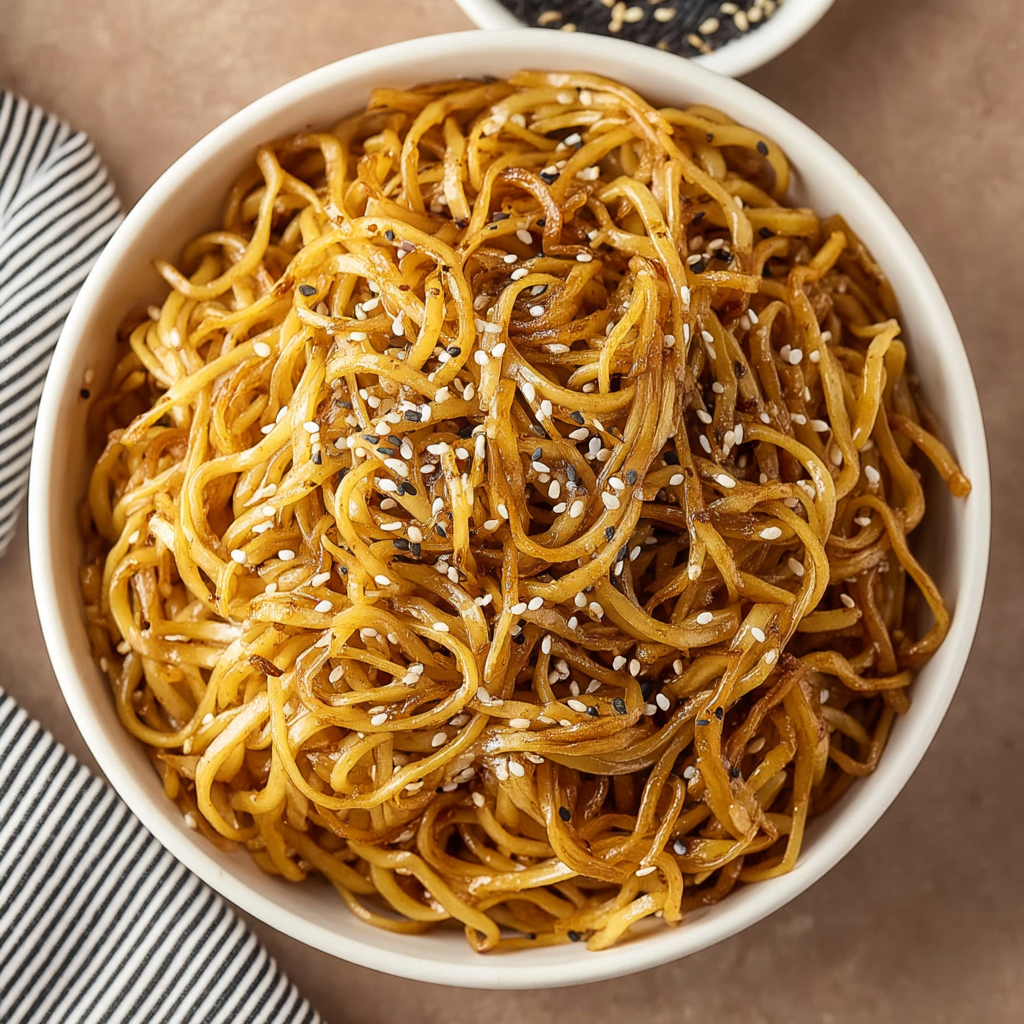1. Introduction to the Recipe
There’s something irresistible about the savory, buttery noodles served at hibachi-style restaurants. Good news? You don’t need a teppanyaki grill to recreate that crave-worthy taste at home. This Hibachi Chinese Noodle Dish delivers everything you love: springy lo mein noodles, rich garlic butter, and a soy-sesame glaze that hits all the right notes.
Quick to prep and endlessly satisfying, these noodles are perfect as a side dish or stand-alone meal. You can pair them with grilled shrimp, steak, or tofu—or toss in stir-fried veggies for a meatless main that doesn’t compromise on flavor. The key is balancing umami-packed soy sauce and sweet brown sugar with garlic, butter, and the nutty depth of sesame oil.
If you’re unfamiliar with lo mein or need a substitute, check out this noodle guide to find your perfect match. And for tips on boosting flavor in stir-fries and noodle dishes, this flavor layering article is worth a read.
These hibachi Chinese noodles make it easy to impress at home with minimal effort. They come together in under 20 minutes, use basic pantry ingredients, and can be customized endlessly to suit your mood or pantry. Want it spicy? Add chili flakes. Need more protein? Toss in grilled chicken.
They’re also great as leftovers. Reheated with a splash of soy sauce or sesame oil, they taste just as delicious the next day. It’s the kind of recipe you’ll memorize after the first few tries—a go-to side dish or full meal that never disappoints.
Let’s get into the recipe, then we’ll explore how to level it up even further with advanced techniques and tips.
2. Basic Recipe: Ingredients and Instructions
Print
Hibachi Chinese Noodle Dishes
Description
Make this hibachi Chinese noodle dish at home in 20 minutes! Buttery, garlicky, and loaded with flavor. Better than takeout.
Ingredients
– 1 pound Lo Mein noodles
– 3 tablespoons butter
– 1 tablespoon minced garlic
– 3 tablespoons brown sugar
– 3 tablespoons soy sauce
– 1/2 teaspoon salt
– 1/2 teaspoon pepper
– 1 tablespoon sesame oil
– 1 tablespoon sesame seeds (for topping)
Instructions
1. Cook noodles according to package instructions. Drain and set aside.
2. In a large skillet or wok, melt butter over medium heat. Add garlic and cook for 30 seconds until fragrant.
3. Stir in brown sugar, soy sauce, salt, pepper, and sesame oil. Mix well and bring to a low simmer.
4. Add cooked noodles to the skillet and toss to coat evenly in the sauce. Cook for another 2-3 minutes, stirring frequently.
5. Serve hot, topped with sesame seeds. Optionally garnish with sliced green onions or a drizzle of extra sesame oil.
Notes
– Use fresh lo mein noodles if available; otherwise, spaghetti or ramen noodles work in a pinch.
– Add sautéed mushrooms, onions, or shredded cabbage for a veggie boost.
– Make it spicy with a pinch of red pepper flakes or a splash of sriracha.
Keywords: Hibachi Chinese Noodle Dishes
3. Advanced Techniques
Use a Smoking Hot Pan for Wok Hei
To mimic the flavor of a true hibachi grill, preheat your skillet until it’s smoking hot before adding any ingredients. This brings out a slight char and deep umami known as “wok hei,” or the breath of the wok. It creates complex flavor without adding more ingredients.
Brown the Butter for Extra Depth
Instead of simply melting the butter, let it brown slightly until it smells nutty and golden. This step takes just an extra minute but adds a rich, caramelized layer of flavor that takes the sauce up a notch.
Finish with a Glossy Sauce Boost
Before serving, add an extra drizzle of sesame oil and a splash of soy sauce. Toss the noodles one last time. This ensures a silky, glossy finish and elevates the flavor, giving it a restaurant-quality look and taste.
Flash Fry for Texture
For noodles with a slight crisp, toss them in the skillet on high heat for a couple of minutes without stirring constantly. Letting them sit creates crispy edges and contrast against the chewy interior.
Add Aromatics like Ginger or Scallions
Toss in thin slices of fresh ginger or chopped scallions with the garlic to build more complexity. These aromatics release oils that blend beautifully into the sauce and create a more rounded flavor.

4. Storage, Shelf Life, and Maintenance Tips
Refrigeration
Store any leftovers in an airtight container in the fridge for up to 4 days. For best results, reheat in a skillet with a tablespoon of water or soy sauce to loosen the noodles.
Freezing Tips
While best fresh, these noodles can be frozen. Cool completely, portion into airtight bags, and freeze for up to 1 month. Reheat directly from frozen in a skillet or microwave.
Prevent Noodle Clumping
Before storing, drizzle noodles with a small amount of sesame oil and toss to coat. This prevents sticking and keeps the noodles easy to reheat.
Meal Prep Friendly
You can make a big batch and portion it into containers with steamed veggies or grilled protein for grab-and-go lunches that taste just as good the next day.
Reheat Without Drying Out
Avoid using the microwave without moisture. Always add a splash of water or broth to bring back the saucy texture. Cover with a damp paper towel when microwaving for better results.

5. Dietary Adaptations and Substitutions
Gluten-Free Version
Substitute soy sauce with tamari or coconut aminos, and replace traditional lo mein with rice noodles, soba (if gluten-free certified), or GF spaghetti.
Vegan-Friendly Option
Use plant-based butter or avocado oil in place of dairy butter. All other ingredients are naturally vegan. For added protein, toss in tofu cubes or edamame.
Low-Sugar Variation
Reduce the brown sugar to 1 tablespoon or substitute with monk fruit sweetener or coconut sugar for a more natural, low-glycemic version.
Low-Sodium Hack
Use a low-sodium soy sauce and skip the added salt. Add flavor with fresh lime juice, garlic, or a dash of rice vinegar.
Protein-Enhanced Version
Add a scrambled egg, diced grilled chicken, tofu, shrimp, or even tempeh for a well-rounded meal that hits all the macros.

6. FAQs About the Recipe
What kind of noodles can I use if I don’t have lo mein?
Spaghetti, linguine, or ramen noodles work well. Udon and soba can also substitute, though texture will vary. Just be sure not to overcook.
Is this the same as yakisoba or chow mein?
Not quite. While similar, yakisoba has a tangy Worcestershire-based sauce and chow mein is often pan-fried with different ingredients. This dish is more like the buttery soy-glazed noodles served at hibachi restaurants.
Can I double or triple the recipe?
Yes, but cook in batches to avoid steaming the noodles. Overcrowding the pan makes it hard to coat everything evenly and can cause sogginess.
How do I make it spicy?
Add chili oil, red pepper flakes, or sriracha either to the sauce or as a finishing drizzle. Sambal oelek also works great for a more complex heat.
Can I prep this in advance for a party?
Absolutely. You can make the sauce a day or two ahead and cook the noodles just before serving. For potlucks or large gatherings, keep warm in a slow cooker on low.

7. Conclusion & Final Thoughts
This Hibachi Chinese Noodle Dish is the kind of recipe that quickly becomes a favorite. With its buttery, garlicky sauce and sweet-savory balance, it delivers on comfort and craveability without the takeout price tag. Even better? It’s endlessly customizable and lightning-fast to make.
Whether you’re serving it as a main course with grilled protein or letting it shine as a side dish, it always hits. The balance of textures and bold flavors makes it satisfying for both casual weeknight meals and special occasions.
Once you master the base, you can play with the formula—adding spice, swapping in different noodles, or leveling it up with crispy vegetables and wok hei techniques. No matter how you tweak it, one thing stays constant: it’s seriously delicious.
So next time you’re in the mood for noodles, skip the takeout app and fire up your skillet. This dish is simple enough for beginners and satisfying enough for pros.
